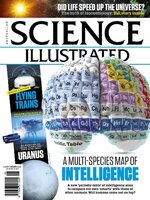Science Illustrated delivers natural science, break through discoveries and an understanding of the world for the entire family. Packed with stunning photography and in-depth editorial it’s a visually spectacular gateway to the world looking into the beginning of life to distant objects in the universe.
SUBSCRIBE & START SAVING NOW!
Science Illustrated Australia
Fire power: Hunga Tonga before the blast
Endangered Aussies: tracking northern quolls
Stars mostly exist in pairs • The majority of binary star pairs were born together from the same cloud of dust and gas.
Stars swallow their own planets • Planets in alien solar systems can get so close to their stars that they get swallowed. According to new research, the process happens more frequently than astronomers used to think likely.
Sucking in a million tonnes of CO2 a year • In Scotland, the world’s biggest CO2 collection plant is in the pipeline.
Citizen science is successful in more ways than one, finds study
New tool will help black-hole hunters re-examine old data • A new Australian-developed algorithm simplifies the search for supermassive black holes using old data and new.
Iceland is the remains of a sunken continent • Iceland may not have been formed by volcanoes. Geologists now suspect that it is the tip of a flooded continent.
Enigmatic giant object reshuffles the Milky Way • A huge gas cloud raises questions about our galactic neighbourhood, and could give the Milky Way a fifth arm.
Can’t fly, but looks great – how vanity grounded this big-headed pterosaur • Good looks seem to have trumped the ability to fly, according to fossil finds of a pterosaur which evolution grounded some 100+ million years ago.
Did Australia have birds bigger than emus and cassowaries? • Aside from ostriches, Australia today is home to the largest birds in the world. But was there ever anything bigger, and what happened to them?
TOP 5 • Which stars are the largest in the universe?
What is a superpressure balloon? • “I read that ‘superpressure’ balloons can maintain their altitude high up in the atmosphere day and night. Is that possible, and how would it work?”
How are dinosaurs weighed? • How can scientists know the weight of a dinosaur when they clearly can’t weigh one?
The world’s most toxic tree? • “Here’s a picture [below] of a sign in Wingham Brush Nature Reserve, warning of stinging trees. Are there any trees more toxic than these?”
WHAT IS THIS? • The world’s first genuine millipede
Which is our strongest muscle? • Are our muscles equally strong when compared to size? Or is one the strongest?
…there’s a five-second rule for dropped food? • Is it true that food from the floor can be eaten without any health risk if it was on the floor for no more than 5 seconds?
WHAT’S NEXT FOR THE JAMES WEBB SPACE TELESCOPE? • After a delay of 14 years, NASA gave global astronomers a big Christmas Day present by launching the biggest space telescope yet into space. Once fully operational, the James Webb Space Telescope should show us things – and times – that we have never seen before.
Telescope unfolded in space • The James Webb telescope has travelled 1.5 million kilometres into space on its 29-day journey. En route, it has gradually unfolded, getting ready to take otherwise unachievable pictures of our universe.
Mirrors to capture invisible light • With the telescope unfolded into its final position, the individual mirrors are tweaked to nanometre precision to bring all 18 segments into perfect alignment. Then the mission can truly begin, with the primary mirror capturing infrared light, which the secondary mirror directs to the instruments.
5 mysteries to solve • Thousands...

 Issue 111
Issue 111
 Issue 110
Issue 110
 Issue 109
Issue 109
 Issue 108
Issue 108
 Issue 107
Issue 107
 Issue 106
Issue 106
 Issue 105
Issue 105
 Issue 104
Issue 104
 Issue 103
Issue 103
 Issue 102
Issue 102
 Issue 101
Issue 101
 Issue 100
Issue 100
 Issue 99
Issue 99
 Issue 98
Issue 98
 Issue 97
Issue 97
 Issue 96
Issue 96
 Issue 95
Issue 95
 Issue 94
Issue 94
 Issue 93
Issue 93
 Issue 92
Issue 92
 Issue 91
Issue 91
 Issue 90
Issue 90
 Issue 89
Issue 89
 Issue 88
Issue 88
